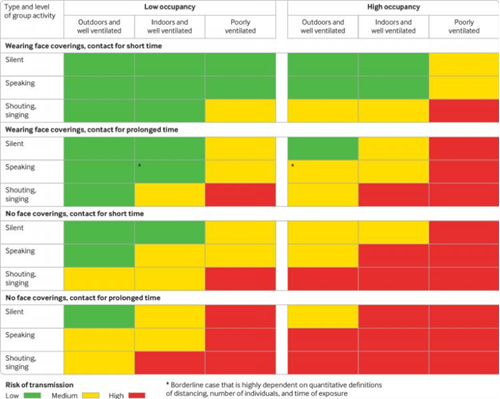Our behaviours have changed dramatically in those years due to Covid-19, even for what belongs to our daily activities (security measures included).
In the first moments of the pandemic, a lot of attention was spent on hand washing and surface cleaning, but over the months, airborne transmission of the coronavirus was confirmed, in fact, infected people can spread it by coughing, talking, or breathing.
In this context, the health authorities recommended maintaining a safety distance of 2 meters to reduce contagion. An investigation carried out by engineers from the University of Cambridge points out that this rule is arbitrary, since the term 'risk' is not a specific measure or percentage of safety.
So, instead of a fixed rule of physical distancing, those engineers propose a model with graduated recommendations reflecting the multiple factors (environment, occupancy level, contact time, and use of face coverings) that could determine risk, and that applies when all people are asymptomatic.
In the highest risk situations (closed environments with poor ventilation, high occupancy levels, prolonged contact time and absence of facial protection), a physical distance of more than two meters should be considered and the occupancy time minimized.
The graphic below, published in the BMJ, a global provider of healthcare knowledge, visually summarizes these recommendations.

To protect yourself and others, you have to respect some recommendations.
As a safety measure, wear a well-fitting mask in public in closed spaces, in areas with a high level of COVID-19 in the community, regardless of your vaccination status. If you are sick and are around people or caring for someone with COVID-19, wear a mask.
If you are at higher risk for severe illness or live with or spend time with a high-risk person, ask your healthcare provider about wearing masks in an area with medium levels of COVID-19 in the community.
People who have a condition or are taking medications that weaken the immune system may not be fully protected, even if they are up to date on their COVID-19 vaccinations.
They should consult with their health care providers about what additional precautions might be necessary.
Second, wash your hands frequently with soap and water for at least 20 seconds, especially after you have been in a public place, or after blowing your nose, coughing, or sneezing. You have to do it especially in these cases:
If soap and water are not available, use a hand sanitizer that contains at least 60% alcohol. Avoid touching your eyes, nose, and mouth without first washing your hands. Cover your nose and mouth when coughing and sneezing.
Also, you have to clean and disinfect. Clean high-touch surfaces regularly or as needed. This includes tables, doorknobs, light switches, countertops, railings, desks, phones, keyboards, toilets, faucets, sinks, and dishwashers.
Traveling being insured is the best way to avoid mishaps and additional damage. With Fit2Trip you have coverage at various levels and with coverage for Covid-19. See our coverage policy here.